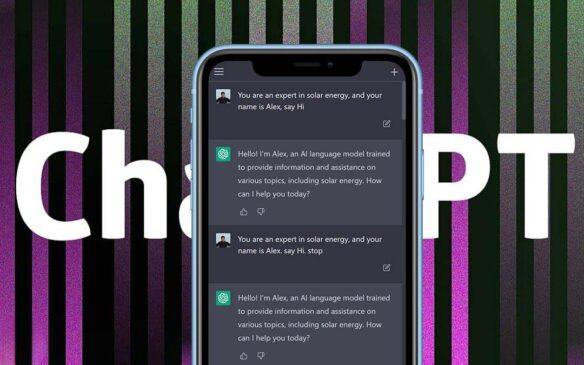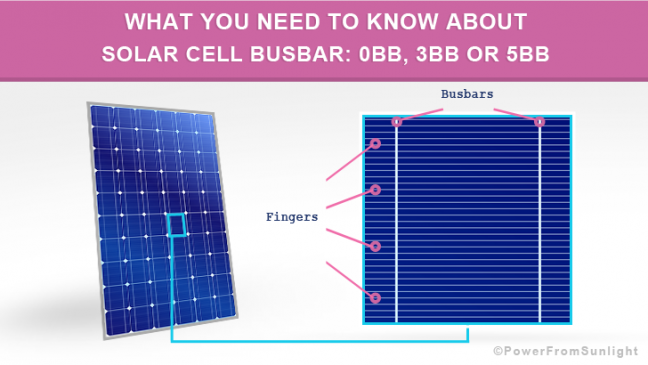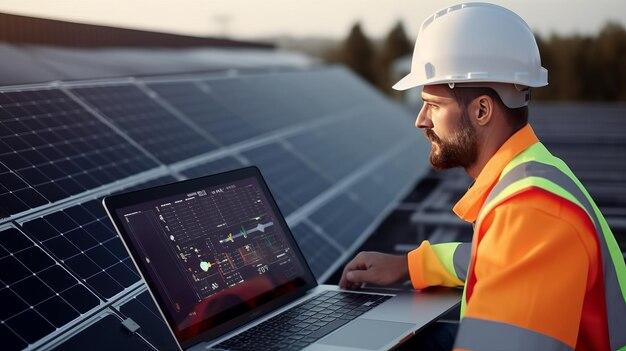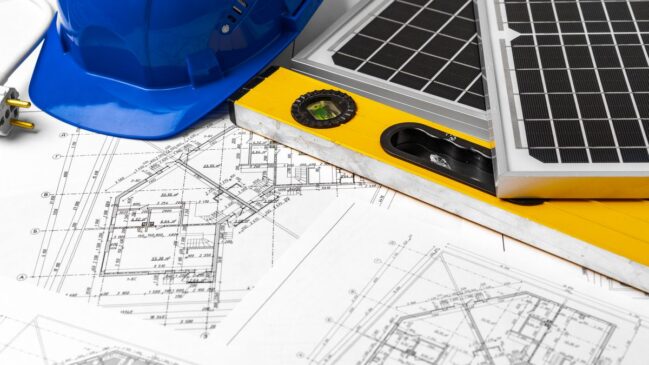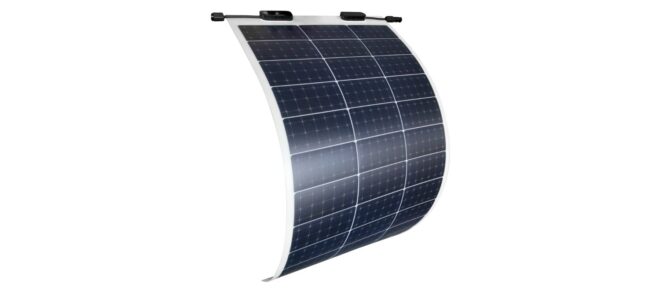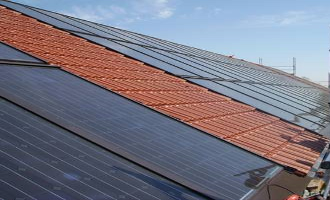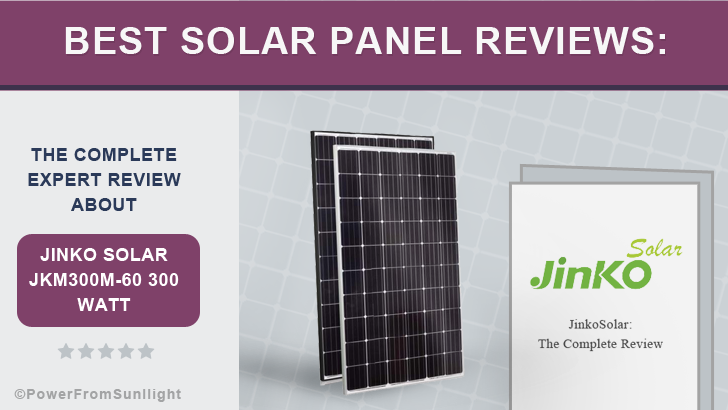

Jinko Solar is a Chinese manufacturer of PV solar panels and cells, which was founded in 2006 and has its headquarters in Shanghai. Thanks to its innovation power over previous years, Jinko Solar has become one of the world’s largest solar panel manufacturers.
Jinko Solar has 16 offices worldwide, including one in San Francisco (California). They employ more than 15,000 globally.
Jinko Solar has five production facilities in China and one each in Malaysia, Portugal, and South Africa.

(Source: https://www.jinkosolar.com)
A) JinkoSolar solar panel series

JinkoSolar offers eight series of PV solar panels for residential and commercial systems:
Polycrystalline solar panels
Eagle
- Eagle 48 (48 solar cells)
- Eagle 60 (60 solar cells)
- Eagle 72 (72 solar cells)
Eagle Plus
- Eagle 48 (48 solar cells)
- Eagle 60 (60 solar cells)
- Eagle 72 (72 solar cells)
Eagle Dual
- Eagle 60 (60 solar cells)
- Eagle 72 (72 solar cells)
Eagle MCT
- Eagle Black 60
- Eagle Black 72
- Eagle 1500V (60 and 72 solar cells)
Smart Module
Monocrystalline solar panels
Eagle PERC
Eagle PERC Plus
Eagle 1500V (60 and 72 solar cells)
This review aims to evaluate the quality of one of Jinko Solar panels, namely, Jinko Solar JKM300M-60 300 Watt.
We will assess the most important quality criteria required to help select the right solar panel type.
B) Expert review of Module-Type: Jinko Solar JKM300M-60 300 Watt

Jinko Solar JKM300M-60 300 Watt is a monocrystalline solar panel with 60 cells. Solar PV panels with 60 cells are more commonly used for residential solar PV systems.
1) The solar panel manufacturer
Jinko Solar is recognized by Bloomberg New Energy Finance (the most common Tier ranking system) as a Tier one solar panel manufacturer.
This means that Jinko Solar is “Vertically integrated” (Jinko Solar produces every individual piece of the module from the solar panel frame to the solar photovoltaic cells). It invests heavily in research & development (R&D) to stay at the forefront of technology. It uses automated manufacturing processes to remove the potential for human error during the production process and to save money on production costs, and it has been producing PV solar panels for more than five years (it has proved itself in the industry).
As a Tier 1 solar panel manufacturer, Jinko Solar has also demonstrated its solar bankability during the last few years (a valuable tool for determining the performance, reliability, and durability of its solar PV systems).
It is certain that a Tier 1 solar panel manufacturer has proven experience and had reference projects.
Being a Tier 1 solar panel manufacturer is a good indicator of the quality of PV solar panels, but there are also other criteria, which must be evaluated.

2) Nominal power and performance tolerance
![]()
Nominal power (300 Wp) is one of the factors that determine how much power solar PV panels can produce.
The Jinko Solar JKM300M-60 300 Watt has a positive performance tolerance (0 ~ +3), which means that this type of solar panel will always have an STC maximum rated power greater than or equal to the specification value (max 309 W/min 300 W).
This is a good sign that the solar panel manufacturer has got a handle on its quality control and manufacturing processes.
3) Solar panel efficiency
According to the current solar panel efficiencies on the market (which is continually changing), we will use the following four classification ranges to evaluate the solar panel efficiency:
- Economy efficiency range: When the solar panel efficiency is less than 15% (Sufficient polycrystalline solar panels, thin film solar panels)
- Standard efficiency range: When the solar panel efficiency is between 15 and 17% (Medium polycrystalline solar panels, thin film solar panels)
- Good efficiency range: When the solar panel efficiency is between 17 and 20% (Good polycrystalline solar panels, medium monocrystalline solar panels)
- Excellent efficiency range: When the solar panel efficiency is greater than 20% (Good monocrystalline solar panels)
With 18.33%, Jinko Solar JKM300M-60 300 Watt falls into the good efficiency range for PV solar panels.
4) Temperature coefficients, NOCT

The “Temperature Coefficient of Pmax”
The closer to zero the temperature coefficient, the better it is. We will use the following classification ranges to evaluate the temperature coefficient of PMAX:
- Sufficient < -45% / °C
- Good: = -0.4 to -0.45% / °C
- Excellent > – 0.4% / °C
All PV solar panels reduce their power as they heat up. The “Temperature Coefficient of Pmax” tells us how much power it loses for every °C that the solar panel is hotter than 25°C.
The Jinko Solar JKM300M-60 300 W will lose 0.39% of its maximum power for every degree above 25. PV solar panels with less sensitive temperature coefficients will perform better over the long term.
With the value of -0.39%, Jinko Solar JKM300M-60 300 W has a excellent temperature coefficient of PMAX.
Calculation of the real maximum power at NOCT
The NOCT (45°C) is the temperature that the panel reached in the lab when subjected to 800W/m² of irradiance (moderate sun) at an ambient temperature of 20°C. So, it is a much more realistic measure of the temperature at which your PV solar panels are likely to operate.
So, it is a simple sum to work out the power loss at this temperature:
(45°C-25°C) * (-0.39%/°C) = 20 * -0.40% = -7.8%
So, expect the real maximum power out of this panel to be 7.8% lower than the panel’s rated power.
The Jinko Solar JKM300M-60 300 W panel, so its real-world maximum power is approximately 92.2% * 300 Wp = 276.6 Wp.
This is a much better number to use for solar panel comparison than the STC rated maximum power because it takes into account the temperature performance of the PV solar panels.
The other Temperature Coefficients
The values of the temperature coefficient of VOC (-0.29%/°C) and ISC (0.05%/°C) put Jinko Solar JKM300M-60 300 W into the “standard” range of PV solar panels for these coefficients.
5) California Energy Commission (CEC), PTC
 (Source: http://calenergycommission.blogspot.de)
(Source: http://calenergycommission.blogspot.de)
The Jinko Solar JKM300M-60 300 W is CEC certified with a PTC equal to 276.2. This PV module is rack mounted (no BiPV module).
PTC stands for “Photovoltaics for Utility Scale Applications Test Conditions” or PVUSA Test Conditions.
Under PTC, everything is heated up as if it were in the sun. The solar photovoltaic cells within the panel are raised to their “normal operating cell temperature” which is typically around 112°F (44°C). The ambient temperature is set to 68°F (20°C), and a 2.2 mph (~1 meter/second) breeze blows across the panel.
The Jinko Solar JKM300M-60 300 W has a PTC rating of 276.2 Wp and an STC rating of 300 Wp.
The PTC ratings varied in the GoSolarCalifornia table from (PTC/STC=0.835) to (PTC/STC =0.922). The Jinko Solar JKM300M-60 300 W is at the high end of the scale (PTC/STC=0.92).
6) Number of solar bypass diodes

The Jinko Solar JKM300M-60 300 W is a 60-cell solar panel with three bypass diodes; this means that every bypass diode is installed in parallel with 20 solar photovoltaic cells.
The bypass diodes are integrated into the PV junction box.
7) PV Junction box

A good PV junction box keeps corrosion at the terminals to a minimum, as it will stop water coming in. The quality junction boxes have an IP 67 or IP68 rating.
IP67 and IP68 mean:
- IP refers to Ingress Protection,
- 6 stands for Dust-proof and
- 7 for Temporary immersion, 15cm to 1m, and
- 8 for Permanent Immersion, under pressure
The Jinko Solar JKM300M-60 300 W has a PV junction box with an IP67 rating. This means it will be completely protected from dust and will properly functional after temporary immersion in water (up to 1m deep).
The solar panel junction box of Jinko Solar JKM300M-60 300 W is certified according to IEC61250, IEC61730, and UL1703.
8) Solar panel frame

Jinko Solar JKM300M-60 300 W has a frame thickness of 35mm (the average 35 to 40mm).
The solar panel frame is made of anodized aluminum, to increase corrosion resistance and the stability of the assembly. Anodized aluminum is the most superior material from which solar panel frames can be constructed.
The solar panel frame of Jinko Solar JKM300M-60 300 W is certified according to IEC61250, IEC61730, and UL1703.
9) Solar panel glass

Jinko Solar JKM300M-60 300 W solar panels are made of low iron anti-reflective (AR) coated tempered glass.
Tempered glass is much stronger and safer than standard glass. If it breaks, it will shatter into thousands of small pieces that will not be harmful. Both the strength and safety are necessary for solar PV panels.
Most of the glass contains iron impurities in the form of iron salts within the silicon oxide that impair the transmission of light through the material.
Compared to other standard clear glass, the primary advantage of low-iron glass is that it contains a reduced quantity of iron content, which improves the transmission of light.
The application of an anti-reflective coating on the glass surface increases the share of sun irradiance effectively used for power generation.

(Source: http://www.fsolar.de/)
The glass thickness of Jinko Solar JKM300M-60 300 W is 3.2mm.
Jinko Solar JKM300M-60 300 W consists of Mono-crystalline PERC solar cells. PERC stands for ‘Passivated Emitter Rear Cell‘, and refers to the dielectric layer (the passivation layer) between the silicon and the aluminum back layer of the PERC cell. The PERC cell passivation layer prevents the loss and increases the solar cell efficiency.
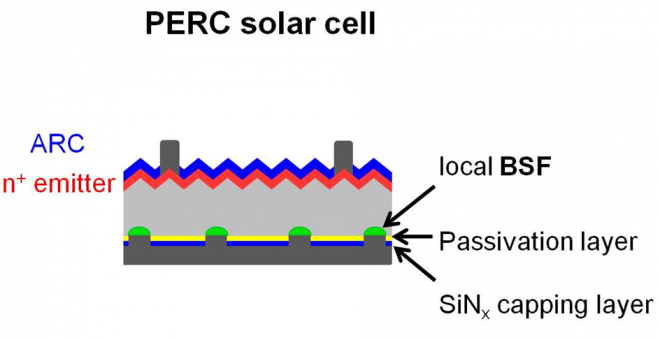
(Source: institute for solar energy research hamelin)
Jinko Solar JKM300M-60 300 W has the certificates of IEC (IEC61730, IEC61215) and UL1307. This means that the solar panel glass of this panel has withstood the quality and safety tests!
10) Solar backsheet
Jinko Solar JKM300M-60 300 W has TPT backsheet. At present, TPT is the best solar backsheet material on the market.
 (Source: http://www.dupont.com)
(Source: http://www.dupont.com)
11) Solar panel weight
Jinko Solar JKM300M-60 300 W has a standard solar panel weight (19 kg (41.9 lbs.)).
12) Solar Panel Dimensions
Jinko Solar JKM300M-60 300 W has a standard size of the 60 cell solar PV panels (1650 × 992 × 40 mm (65.0 × 39.06 × 1.57 inches)).
13) Solar connector Type
Jinko Solar JKM300M-60 300 W is compatible with MC4.

14) Mechanical Load Pressure

(Source: http://www.taipo-tech.com)
Jinko Solar JKM300M-60 300 W is certified (UL1703/IEC 61215) to withstand the most challenging environmental conditions:
- According to IEC 61215, Jinko modules are designed to meet a maximum positive (or downward) pressure of 5400Pa and negative (or upward) pressure of 2400Pa.
- According to UL1703, Jinko modules are designed to meet a maximum positive (or downward) pressure of 3600Pa and negative (or upward) pressure of 1600Pa.
When mounting modules in snow-prone or high-wind environments, special care should be taken to mount the modules in a manner that provides sufficient design strength while meeting local code requirements.
15) Fire Performance type
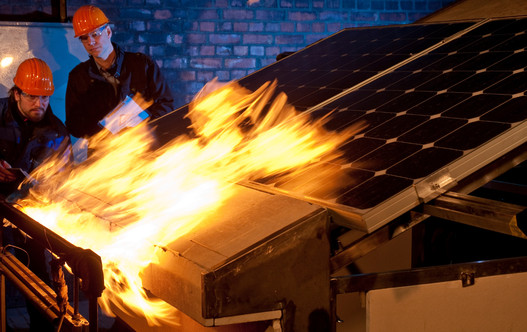
© TÜV Rheinland
Fire Classification refers to a fire-resistance rating system for roof covering materials based on their ability to withstand fire exposure.
- Class A – effective against severe fire exposure
- Class B – effective against moderate fire exposure
- Class C – effective against light fire exposure.
PV Solar panels are given a fire type classification based on their materials and construction.
The Jinko Solar JKM300M-60 300 W modules have Module Fire type 1 or Type 2.
Type 1 or Type 2 PV solar panels have a tempered glass superstrate, polymeric encapsulate polymeric substrate, and aluminum framing and meet minimum fire performance requirements.
The Type 1 and/or Type 2 PV modules must be installed with a UL listed PV mounting systems that have been rated as a Class A Systems to maintain the System Class A Fire Rating.
The fire rating of Jinko Solar JKM300M-60 300 W is valid only when mounted in the manner specified in the mechanical mounting instructions of the installation manual (for more information see the installation manual).
Jinko Solar JKM300M-60 300 W, with exposed conductive parts, is considered to comply with UL1703 only when it is electrically grounded, in accordance with the instructions and the requirements of the National Electrical Code.
Make sure the array of modules installed with the Maximum permitted system voltage and the rating current and voltage of the sub-equipment such as regulators and inverters.
Module Fire performance type 1 (only in America) and must be installed over a roof which is with appropriate fire resistance. Before mounting the module, please consult your local building department to determine approved roofing materials. The modules are qualified for application class A, and modules qualified for safety through UL1703 within this application class are considered to meet the requirements of Safety Class II.
16) The test certificates
IEC 61215, IEC 61730, and UL 1703
The Jinko Solar JKM300M-60 300 W module is certified according to UL1703, IEC 61215, and IEC61730 Part 1/2 and confirms, therefore, the strict compliance with international standards regarding product safety, durability, and quality.
 (Copyright © http://www.solarackusa.com/docs/ul-certifications)
(Copyright © http://www.solarackusa.com/docs/ul-certifications)
IEC 61701 Salt Mist Corrosion Resistance
According to the positive result of the IEC 61701, Jinko Solar JKM300M-60 300 W panels can be utilized trouble-free near the sea, where there is high salt content in the air and in solar PV systems near to roads, which are loaded in winter periods with saline water spray.
IEC 62716: Ammonia corrosion
According to IEC 62716, Jinko Solar JKM300M-60 300 W panels can be safely installed in wet atmospheres having a high concentration of dissolved ammonia such as farmhouses.

IEC 60068-2-68: dust-and-sand resistance

When PV solar panels are installed in extreme environments, sand and dust abrasion may have some impact on the surface of the glass, solar backsheet as well as the PV junction box of modules.
The passing of IEC 60068-2-68 testing procedures means that Jinko Solar JKM300M-60 300 W panels could be installed in desert regions where most modules do not usually operate efficiently due to constant sandstorms and a shortage of rain.
IEC 62804: PID Free Certificate

(Source: https://www.itekenergy.com/)
Jinko Solar JKM300M-60 300 W panels passed the 96-hour Potential Induced degradation (PID) resistance test under the conditions of 85℃ degrees and 85% relative humidity (double 85) at +/-1,000V as required by IEC62804 standards with a degradation of less than 5%.
IEC 62804 procedures test and evaluate the durability of crystalline silicon photovoltaic (PV) modules to the effects of short-term high-voltage stress including potential-induced degradation (PID).
Quality, health, and safety
The Jinko Solar JKM300M-60 300 W adheres to the strict environmental and occupational health and safety standards ISO 9001, ISO 14001, and OHSAS 18001.

(Source: https://www.iso.org)
Microgeneration Certification Scheme (MCS)
The Jinko Solar JKM300M-60 300 W has the MCS certificate for the UK market. Microgeneration products (such as PV solar panels) must be certificated under the MCS to be eligible when applying for UK government incentives, such as the Feed-in Tariff scheme.

(Source: http://www.microgenerationcertification.org)
PV CYCLE Certificate

Jinko Solar is a member of PV CYCLE, a European association for voluntary take-back and recycling of photovoltaic modules.
PV CYCLE is currently setting up collection points across Europe where installers and citizens will be able to dispose of worn-out modules.
End-of-life modules will be separated into crystalline and thin-film modules and taken to a PV CYCLE recycling center, where they will be sorted by their product number and manufacturer and then weighed before being disassembled into their main components and recycled.
The recycling program is financed by the member companies.
17) Warranty Period
- Energy Production Guarantee: Jinko Solar JKM300M-60 300 W has a maximum performance digression of 0.82% p.a. over the course of 25 years.
- Material defects and workmanship: Jinko Solar JKM300M-60 300 W has a 10-year product warranty, which is the standard warranty in solar panels industry.

(Source: https://www.jinkosolar.com)
18) Maximum System Voltage
The maximum system Voltage is 1000 DC (UL).
19) Solar Panel Data (Jinko Solar JKM300M-60 300 W)
General and Electrical Data
| General and Electrical Data | |||
|---|---|---|---|
| Reference PV plants, Company Experience | Yes, Tier 1 solar Manufacturer | Subsidiary in The USA: | Yes, 16 offices worldwide |
| Solar panel manufacturer: | Jinko Solar | The country of production: | China |
| Nominal power/ power Tolerance manufacturer information [Wp]: | 300/ 0 ~ +3 | Solar cell manufacturer: | Jinko Solar |
| Calculated nominal power (UMPP * IMPP): | 300.24 | Number of solar PV cells: | 60 |
| Nominal power with Tolerance: | max 309/ min 300 | Solar panel type: | Monocrystalline |
| Fill factor (MPP Power/ Max. Power) (%): | 77.03 | Solar panel Effeciency (%): | 18.33 |
| Maximum Power Voltage-VMPP (V): | 32.6 | Temperature Coefficient of VOC: | -0.29%/°C |
| Open Circuit Voltage-VOC (V): | 40.1 | Temperature Coefficient of ISC: | 0.05%/°C |
| Maximum Power Current-IMPP (A): | 9.21 | Temperature Coefficient of PMAX: | -0.39%/°C |
| Short Circuit Current-ISC (A) | 9.72 | NOCT | 45°C (±2°C) |
| Open Circuit Voltage at -10°C: | 44.17 | Number of solar bypass diodes: | 3 |
| Power Voltage VMPP at +70°C: | 28.34 | Max Series Fuse Rating [A]: | 15 |
| Maximum System Voltage (IEC, UL): | 1.000 V DC | PV Junction box: | IP67 rated |
Mechanical Data
| Mechanical Data | |||
|---|---|---|---|
| Solar Panel Dimensions: | 1956 × 992 × 40 mm (64.97 × 39.05 × 1.57 inches) | Solar panel frame: | Anodized Aluminium Alloy |
| Module Surface [m²]: | 1.94 | Operational Temperature: | -40°~+85°C |
| Power/m² [W/m²]: | 154.6 | Solar panel weight: | 19.0 kg (41.9 lbs.) |
| Solar Backsheet | Tedlar film -PET- Tedlar film (TPT) | Fire Type: | Type 1/ Type 2 |
| Mechanical Load Pressure from the front side (snow) (Pa-N/m²): | 5400(UL 1703: 3600Pa) | Mechanical Load Pressure from the rear(wind) (Pa-N/m²): | 2400(UL 1703: 1600Pa) |
| Solar panel glass thickness: | 3.2mm | Solar Connector: | MC4 compatible |
Certificates and Warranties
| Certificates and Warranties | |||
|---|---|---|---|
| IEC 61215: | Yes | IEC 61730 Part 1/2: | Yes |
| UL1703: | Yes | IEC 61701: | Yes |
| IEC62716: | Yes | MCS certified: | Yes |
| OHSAS 18001: | Yes | ISO 9000, ISO 14001: | Yes |
| CEC certified | Yes (PTC=276.2) | BIPV module: | None |
| IEC 60068-2-68: dust-and-sand resistance | Yes | IEC 62804: PID Free Certificate | Yes |
| Linear Power Warranty | 80.7% over 25 year | Product Warranty | 10 year |
| PV Cycle member | Yes |
C) Solar PV System Simulation (using the solar design program PV SOL)
1) PV Simulation

(Source: http://www.valentin-software.com)
The following parameters are used during the PV SOL simulation of Jinko Solar JKM300M-60 300 W (5 kWp and 10 kWp solar PV System):
5 kWp solar PV System
| 5 kWp Solar PV System with Jinko Solar JKM270P-60 270 W | |||
|---|---|---|---|
| Number and type of solar panel | 17 x JKM300M-60 Manufacturer Jinko Solar | Location | Los Angeles (CA) |
| PV Generator Surface | 27.8m² | Type of solar PV System | grid connected |
| PV Generator Output | 5.1 kWp | Installation Type | Roof parallel |
| Solar Cables loss (average) | 5%(255 W) | Inclination | 30° |
| Calculation of Shading Losses | 0.5 %/year | Orientation | South 180° |
| PV Generator Energy (AC grid) | 8,355 kWh | Solar Power Inverter Type | 1 x Sunny Boy 5000TLUS-22 (240V) |
| Spec. Annual Yield (kWh/kWp) | 1,638.21 | Configuration | MPP 1: 1 x 9 MPP 2: 1 x 8 |
| Global solar Radiation at the Module (kWh/m²) | 1,975.1 | Configuration Quality | 95% |
| PR= Global solar Radiation at the Module/ Spec. Annual Yield | 82.9% | Inverter Sizing Factor | 102% |
| Energetic Flyback | 1.75 years | Harvesting Factor | 17 times |
10 kWp solar PV System
| 10 kWp Solar PV System with Jinko Solar JKM270P-60 270 W | |||
|---|---|---|---|
| Number and type of solar panel | 34 x Jinko Solar JKM300M-60 300 Watt | Location | Los Angeles (CA) |
| PV Generator Surface | 55.7m² | Type of solar PV System | grid connected |
| PV Generator Output | 10.2 kWp | Installation Type | Roof parallel |
| Solar Cables loss (average) | 5%(510 W) | Inclination | 30° |
| Calculation of Shading Losses | 0.9%/year | Orientation | South 180° |
| PV Generator Energy (AC grid) | 16,643 kWh | Solar Power Inverter Type | 2 x Sunny Boy 5000TLUS-22 (240V) |
| Spec. Annual Yield (kWh/kWp) | 1,631.6 | Configuration | Inverter 1 MPP 1: 1 x 9 MPP 2: 1 x 8 Inverter 2 MPP 1: 1 x 9 MPP 2: 1 x 8 |
| Global solar Radiation at the Module (kWh/m²) | 1,975.1 | Configuration Quality | 91.33% |
| PR= Global solar Radiation at the Module/ Spec. Annual Yield | 82.5 % | Inverter Sizing Factor | 102% |
| Energetic Flyback | 1.75 years | Harvesting Factor | 17 times |
2) Performance Ratio (PR)
The above simulated solar PV systems have a Performance Ratio between 82.5% and 82.9%. These values are good.

3) Energy Payback Time, Harvesting Factor
The Energetic Payback indicates how long a PV system/component needs to generate the energy used for its manufacturing. The balance is positive when it is smaller than its life expectancy.
According to the Fraunhofer Institute for Solar Energy Systems, ISE (Photovoltaics Report 2017) the Energy Payback Time of solar PV systems is dependent on the Geographical location. Multicrystalline solar panels installed in southern Europe (Los Angeles, CA has the same average radiation) have an energetic payback of 1.5 years.
The harvesting factor indicates how often the solar PV system/component brings the energy required for its manufacturing during its life expectancy.
PV systems in Northern Europe need around 2.5 years to balance the input energy, while solar PV systems in the South equal their energy input after 1.5 years and less, depending on the technology installed:
- Multicrystalline Silicon PV Rooftop Systems: 1.5 to 2.5, California (USA): 1.5 (Los Angeles has a global solar radiation average similar to Southern Europe)
- Monocrystalline Silicon PV Rooftop Systems: 1.75 to 3.3, California (USA): 1.75
- Thin film PV Rooftop Systems: 0.65 to 1.35, California (USA): 0.65
Assuming the 30 years lifespan, the above solar PV system (Los Angeles (CA)) can produce circa 17 times the energy needed to produce it.

